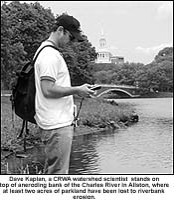By Pallavi Mande / Special To The Tab
While many people are aware of the importance of reducing the environmental impacts of new development on green, open land, there is less emphasis placed on the environmental impacts of development in cities. Yet the relationship between the environment and development is equally important in urban areas. The impacts of urbanization on water are pervasive. Because little rainwater can penetrate the impervious surfaces that cities create, those surfaces deplete groundwater reserves, which in turn depletes the amount of water in our rivers.
 "CRWA, known for its work in protecting, preserving and enhancing the Charles River and its watershed, is creating a new approach to urban redevelopment," said Bob Zimmerman, executive director of Charles River Watershed Association. "We want to build 'blue cities' - cities that are designed to sustain and restore water resources."
"CRWA, known for its work in protecting, preserving and enhancing the Charles River and its watershed, is creating a new approach to urban redevelopment," said Bob Zimmerman, executive director of Charles River Watershed Association. "We want to build 'blue cities' - cities that are designed to sustain and restore water resources."
City infrastructure, comprised of roads, buildings, sidewalks, parking lots, and more, is often designed without taking into consideration the natural flow of water, which often aggravates flooding problems. Because there is nowhere else for water to go, urban rivers are overwhelmed with polluted runoff during rainstorms, exacerbating flooding and pollution problems in the river.
"Urban redevelopment projects present tremendous opportunities to improve the environment, reverse degradation, and correct mistakes," said Kate Bowditch, senior environmental scientist and project manager at CRWA. "The most successful urban renewal incorporates environmental restoration, because of the proven economic benefits as well as because it generates widespread public support."
Existing policy and regulations already require redevelopment projects to reduce polluted runoff, increase groundwater recharge, and conserve water. In many cases, especially in Boston, where Mayor Thomas Menino and the Boston Redevelopment Authority are adopting Green Building standards, redevelopment projects are also adopting practices such as green roofs, water reuse, and incorporation of public open space.
"While these building-scale efforts are a huge step in the right direction, there is much more that can be done at the neighborhood level," said Bowditch. "Redevelopment provides the opportunity to encourage developers to look for ways to participate in improving the neighborhood, and can leverage other public and private investments as well." She added that larger infrastructure improvements to the water and sewer systems, transportation systems, open space and pedestrian amenities, and the urban ecosystem should all be considered whenever large-scale urban development is occurring.
As a case in point, over the next 50 years Harvard University intends to develop over 200 acres it now owns in North Allston to create a new campus south of the Charles. The project presents an opportunity to change current development practices, and create a new approach to planning that is environmentally sensitive and "water friendly".
CRWA has developed partnerships with the participants involved with the Harvard project- Harvard University, the BRA and the residents of the North Allston community. As the Institutional Master Plan for the new campus begins to take shape, CRWA is working closely with each participant group to further the goal of environmental sustainability.
A parallel opportunity exists on Newton's border, as Boston College (BC) plans to develop the 43 acres of land in Brighton that it purchased in 2004 from the Archdiocese of Boston. Like all colleges in Boston, BC must participate in the Boston Redevelopment Authority's institutional master planning process, which requires the school to keep a master plan on file with the city. Changes to the plan, such as major development on new land, require not only city approval but also neighborhood participation. Thus, there exists a tremendous opportunity for large institutional development projects to incorporate measures for environmental restoration and resource conservation. This will have both short-term benefits and will help to achieve sustainability in the longer term.

No comments:
Post a Comment